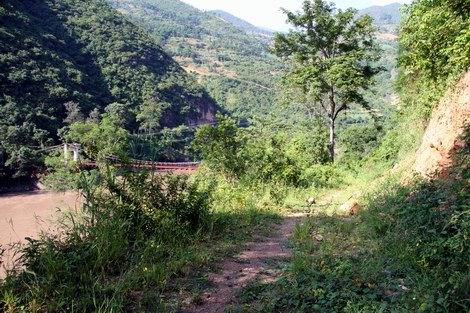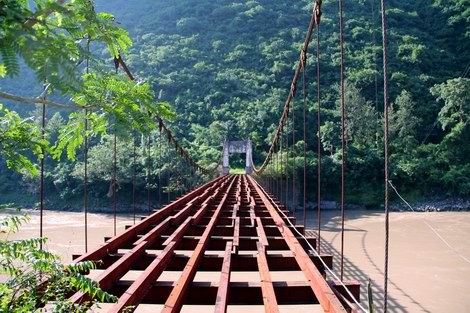
The Huitong Bridge spanning the Nujiang (Salween) River swollen with molten snow and summer rains. (Photo: July 2013).

The Huitong bridge, now with communist star on the rebuild Eastern bridgehead and memorial stone in 2012.
This "Burma Road" bridge (Sometimes spelled as Hwei Tung), with a span of 123 metres, has been preserved as a monument because it was here that the Japanese army was stopped during World war-II. The invaders coming up the Burma road from the South were unable to cross the Nujiang river (Salween) after the bridge was blown up on the 5th of May 1942 by the Chinese defence.
The bridge was reconstructed to handle the supplies coming up the Ledo road after the Chinese recaptured Songshan mountian and the far Western part of Yunnan again at the end of 1944. The present form dates from 1950 and carries the communist star on the rebuild Eastern bridgehead.


The Huitong Bridge seen from the West bank in 1944. The blown Eastern bridgehead is still missing and there are no overhead cables thus the bridge can only handle limited traffic. (©2)
The Huitong Bridge seen from the East bank in 1945. The Eastern bridgehead has been improvised and the bridge can handle fully loaded trucks again. Note the fuel pipeline hanging under the bridge. (©2)

The overgrown eastern bridgehead of the Huitong Bridge was once one of the busiest spots on the Burma Road.


The Huitong Bridge seen from the eastern bridgehead.

Much has changed since World war-II. What ones was a vital and impressing 123 metre crossing 15 metres above the water now looks like a toy. In 1977 a whole new bridge was build just downstream that now dominates the view.
Admission Fee:¥0
Attraction
Transportation:

You will only receive emails that you permitted upon submission and your email address will never be shared with any third parties without your express permission.
